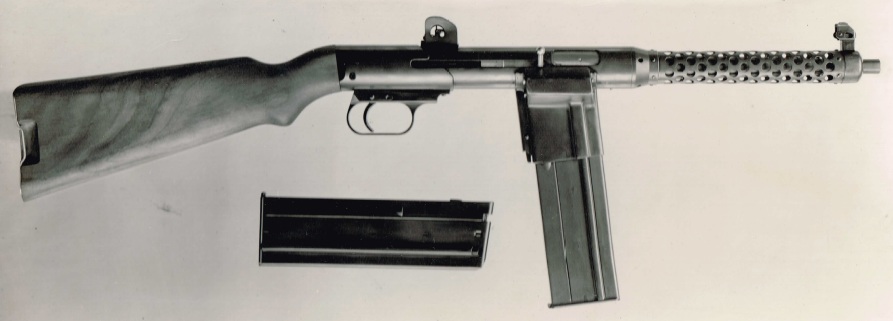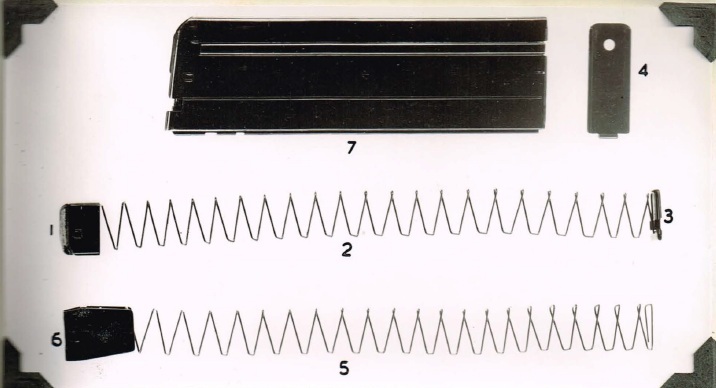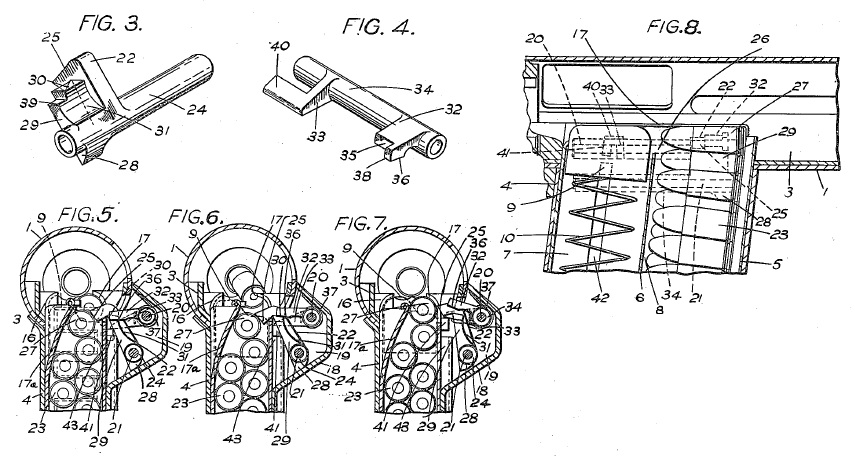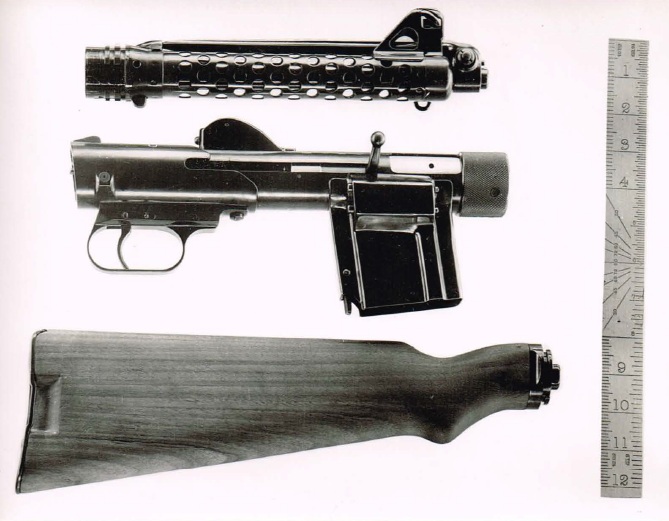The Vesely Machine Carbine (aka V-41, V-42, and V-43) was a submachine gun designed in Britain by a Czech refugee named Josek Vesely. In most respects, the Vesely was a typical subgun, firing 9mm Parabellem cartridges and using a simple blowback mechanism. It offered a selector for semi and full automatic modes, a manual safety, and 900 or 1000 rpm rate of fire (depending on how the bolt was configured). The sights had three settings, for 100, 200, and 300 yards. The standout feature of Vesely’s gun is its magazine, which is a double-column 60-round affair.

This magazine appears to fit a rifle cartridge, until you look at the follower. In fact, it holds two full columns of 9mm pistol cartridges, one behind the other. The front column holds 31 rounds and the rear column holds 29, for a total of 60 rounds capacity per magazine. The magazine well contains a clever mechanism which holds the rear column of rounds depressed below the travel of the bolt until the front column is empty. At that point, the interlock lever is released, allowing the ammo in the rear column to rise into the bolt’s path and feed the gun.


You can find more drawings and a detailed description of how this system worked in the three patents awarded to Josef Vesely (all three are available for free download on the Vesely V-42 page in the Vault).
In addition to a standard model (the V-41 and V-42), a version was also designed specifically for paratroopers. The stand V-42 disassembled by removing the buttstock only, leaving the barrel and receiver as a single unit. This was too large for convenient paratroop use, and the buttstock had a tube which the receiver nested in, and this tube was too fragile for rough handling when the gun was disassembled. That would not normally be an issue, but it wasn’t suitable for strapping into a drop bag and jumping out of an airplane with. Instead, the paratroop version (the V-43) used a set of locking tabs to allow easy removal of the buttstock without any fragile bits being exposed, and also had an interrupted thread to allow the barrel and shroud to be easily removed from the receiver. Along with the gun, a special pack was developed to house the three gun components and three magazines.

The Vesely also included a bayonet mount on the muzzle for a simple spike bayonet. When not needed, the bayonet could be mounted in reverse on top of the barrel shroud for convenient storage.
All in all, the gun seems to have been well thought out and well built. It was not adopted into British (or anyone else’s) service, though – probably because it didn’t ultimately offer very much more than the Sten, which was already in use and significantly cheaper to manufacture.
We have a bunch of documentation on the Vesely, including two technical descriptions, a full-on operator’s manual complete with a bunch of disassembled photos, and three patents awarded to Josef Vesely describing the gun and in particular the unique magazine and feed system. Interestingly, our two descriptions are identical in text, but one calls the gun the V-41 and the other calls it the V-42. Presumably this is simply a paperwork change, as there do not appear to have been any changed to the gun between the two. You can download all of these documents from the Vesely V-42 page in the Vault. We also have a smallish gallery of photos of a V-42 we were able to handle (photos courtesy UK MoD):
[nggallery id=152]


Okay, now that is an absolutely fascinating approach to increasing magazine capacity while maintaining a reasonable envelope. Thanks for another excellent posting!
Modern gun designers could still learn a great deal from Josef Vesely’s design, especially the magazine configuration. What a pity it was not adopted instead of the Sten. While I fully acknowledge that the latter was in the right place at the right time, and had several commendable features to boot, I still don’t think that the trade-offs were truly worth it ( ultimate simplicity, coupled with ease and extreme low cost of manufacture, versus loss of reliability and battlefield durability ).
Somewhwere in that equation is a better balance of factors, and many otherwise excellent weapons that never came to full fruition, such as the V-41/V-42 and the modern-day TRW rifle, are the casualties of a process unfortunately skewed by bad timing, cost ( yes, even in the middle of a world war! ), politics ( eg., the Chauchat/CSRG debacle ) and sundry other considerations.
I’d disagree that the STEN design was at fault, Rather the requirement to use Schmieser’s single feed position mags was the problem.
Had Sheppard and Turpin been allowed to develop their own mag (I’m guessing it would have fed from alternate sides, and have been more robust), things may well have been different.
Check out Patchett’s patents for his SMG when he worked for Sterling, the Magazine forms a major part of the development of that gun from the Lanchester clone of a Schmieser, to a reliable design of Patchett’s own.
Disagreement over the STEN aside, I agree, this looks like a far “nicer” gun.
The two in line mag design, looks like a great idea to link with a bolt stop, for a flush magazine pistol calibre (or short rifle cartridge like hornet, fireball or .17 Mk iv) bolt action carbine.
That’s an excellent point you’ve made, Keith. The Sterling was, and is, a first-rate SMG ( I had the privilege of using one for certain military applications a long time ago ), due in no small part to the integrated magazine design.
As for the idea in your last paragraph, that seems quite intriguing. What else did you have in mind to expand upon that concept, if you don’t mind sharing it?
I don’t like heavy recoil, I injured my neck at a clay shoot about 25 years ago, and heavy recoil usually puts it out again, so I prefer pistol calibres and rounds like .22 hornet.
Most US commercial bolt action sporter actions (Rem 700, Savage 110 etc) have a mag cutout for rounds with a 3.3″ OAL (.30-06, .270 etc)and with a bit of modification would take 3.6 inches for the H&H mag rounds.
That’s conveniently twice the 1.8″ OAL of the hornet and fireball based rounds.
There is therefore room for a 9 or 10 shot tandem column mag with the existing flush floor plate.
Might as well keep the cartridges clean in the gun as getting gritty and wearing holes in my pockets.
There is already a cut off used to hold the top round of the back column of the Vesely mag down, with a little thought, that could also serve as a bolt stop, preventing the bolt from running all the way back until the front front magazine is empty.
I’m not sure what prices are like elsewhere, but in Britain, (probably shot out) .270 sporters are comparatively cheap second hand, and if it is a Savage, .222 head size bolt heads are available, which with a little work, will do for Hornet and 9mm P/.30 Tok too.
Another possibility on a shorter action, is the principal used in the Swedish “Coffin” mags for the Suomi SMG.
The STEN was really a last ditch weapon. So using the German mag to save time wasn’t a bad idea. But, what I wonder is why the Germans used it in the 1st place.
Good question, especially as the German service rifle (and most other service rifles by that time) had a mag which fed from alternate sides (I can’t remember whether a broomhandle mag does too)
I’m not clear on the Villar Perosa either, from the manuals which Ian has posted here in the vault, it’s dificult to tell, but alternate side feed looks like a possibility.
I know that some early schmieser designs used Luger drum mags, but the near 90 degree mag which the STEN inherited is hardly inspired by the Luger mags.
A few US patent numbers for the other mags mentioned.
The STEN mag appears to be Schmeisser 1931 US 1,833,862
Coffin mag for the Suomi; Schillstrom (the o has an umlat) US 2,217,848
Patchett’s mag for the Sterling is US 2,510,831
espacenet seems to give easier downloads than the USPTO site.
Thanks for sharing your thoughts on the magazine modifications. I think you have some really great ideas there! Are you going to try fabricating a set-up as described? If you do, you might be able to take out a patent on it. I’m not all that familiar with UK gun laws although I would imagine that some sort of permitting would be required.
The gun itself is licensed, magazines aren’t (yet!)
I don’t believe in patents, ideas are simple and common, and as far as any which I express go – they’re free to share with anyone willing to read them. making the thing desirable enough and to a price that people are willing to pay for it is the difficult bit.
A very interesting gun!!!
At first glance on appearance looks like a S&W Light Rifle, doesn’t it?
It’s funny to mention that in Russian, the surname of the designer means “Jolly” or “Funny guy” (and I’ve checked – it’s the same in Czech). So I vividly imagine Slavic troops making jokes about their weapon’s designer… it being quite unorthodox.